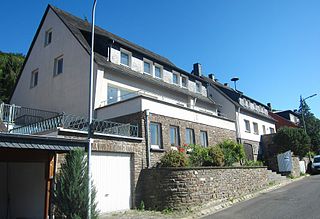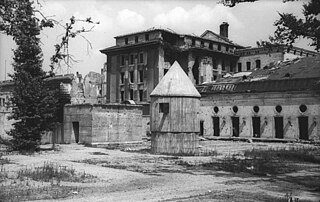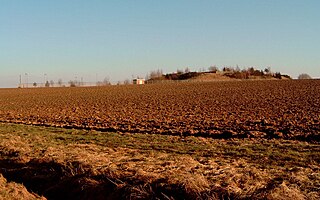 W
WThe Bundesbank bunker was the German central bank's bunker in Cochem (Rheinland-Pfalz) for the preservation of an emergency currency. From 1964 to 1988, the Deutsche Bundesbank stored up to 15 billion marks in the top-secret facility, to protect West Germany from a national economic crisis in the event of potential hyperinflation that might be caused by the Cold War.
 W
WThe Bunker in Berlin-Mitte is a listed air-raid shelter. Originally based on plans of the architect Karl Bonatz, it was constructed in 1943 by Nazi Germany to shelter up to 3,000 Reichsbahn train passengers. The square building has an area of 1,000 square metres (11,000 sq ft) and is 18 metres (59 ft) high; its walls are up to 3 metres (9.8 ft) thick. There are 120 rooms on five floors. In May 1945, the Red Army took the building and turned it into a prisoner-of-war camp. From 1949, it was used to store textiles and from 1957, as storage for dry and tropical fruit.
 W
WThe Fuchsbau is a military bunker system, located south of the town of Fürstenwalde, Brandenburg, about 55 km (34 mi) east of Berlin.
 W
WThe Führerbunker was an air raid shelter located near the Reich Chancellery in Berlin, Germany. It was part of a subterranean bunker complex constructed in two phases in 1936 and 1944. It was the last of the Führer Headquarters (Führerhauptquartiere) used by Adolf Hitler during World War II.
 W
WThe Gossberg is a hill with the highest point of 483 m in the municipality of Wüschheim close to the border with Hundheim in the district of Rhein-Hunsrück-Kreis in the low mountain range of Hunsrück in the state of Rhineland-Palatinate, Germany. The summit was excavated 30 m deep in the period of 1984–1989 and transformed into the NBC bunker operated by U.S. Forces to serve as a fortified center of highly-secure communication among all NATO troops in Europe and a potential missile launch control center for the nearby missile base Pydna in case of anticipated World War III.
 W
WThe Government Bunker (Regierungsbunker) in Germany, officially named Ausweichsitz der Verfassungsorgane des Bundes im Krisen- und Verteidigungsfall zur Wahrung von deren Funktionstüchtigkeit (AdVB), in English: "Emergency Seat of the Federal Constitutional Organs for the State of Crisis or State of Defence to Maintain their Ability to Function" was a massive underground complex built during the Cold War era to house the German government, parliament and enough federal personnel needed to keep the government working in the event of war or severe crisis. Located only about 25 kilometres (16 mi) south of Bonn, Germany, in the Ahr Valley between the towns of Ahrweiler and Dernau, it was one of the best kept secrets of West Germany. It was built between 1960 and 1972 inside two abandoned railway tunnels that were built as part of the Strategic Railway, maintained and kept in a working condition for about 30 years and decommissioned in 1997. A small part of the once-secret site is now open to the public as Government Bunker Documentation Site, while the vast majority is abandoned and sealed.
 W
WHarnekop Nuclear Bunker is a former atomic bomb-proof bunker in the village of Harnekop in Prötzel, in the district Märkisch-Oderland, Brandenburg, Germany. Built over a 5-year period starting in 1971, the structure was the main bunker for the East German Ministry of National Defence and the National People's Army in case of a nuclear attack on the country.
 W
WThe Historische Kunstbunker is a tunnel complex under Nuremberg Castle in the old city of Nuremberg, southern Germany. It forms part of the Nuremberg Historic Mile.
 W
WMaybach I and II were a series of above and underground bunkers built 20 kilometres south of Berlin in Wünsdorf near Zossen, Brandenburg to house the High Command of the Army and the Supreme Command of the Armed Forces during the Second World War. Along with the military fortress complex Zossen, Maybach I and II were instrumental locations from which central planning for field operations of the Wehrmacht took place, and they provided a key connection between Berlin’s military and civilian leadership to the front lines of battle. The complex was named after the Maybach automobile engine.
 W
WThe Festungsfront Oder-Warthe-Bogen, also called the Festung im Oder-Warthe-Bogen or Ostwall, and in Polish the Międzyrzecki Rejon Umocniony, MRU, was a fortified military defence line of Nazi Germany between the Oder and Warta rivers, near Międzyrzecz. The part around Międzyrzecz (Meseritz) has been colloquially referred to as the Regenwurmlager. Built in 1934–44, it was the most technologically advanced fortification system of Nazi Germany, and remains one of the largest and the most interesting systems of this type in the world today. It consists of around 100 concrete defence structures partially interconnected by a network of tunnels. Some of the forts and tunnels are available for visiting.
 W
WThe Festungsfront Oder-Warthe-Bogen, also called the Festung im Oder-Warthe-Bogen or Ostwall, and in Polish the Międzyrzecki Rejon Umocniony, MRU, was a fortified military defence line of Nazi Germany between the Oder and Warta rivers, near Międzyrzecz. The part around Międzyrzecz (Meseritz) has been colloquially referred to as the Regenwurmlager. Built in 1934–44, it was the most technologically advanced fortification system of Nazi Germany, and remains one of the largest and the most interesting systems of this type in the world today. It consists of around 100 concrete defence structures partially interconnected by a network of tunnels. Some of the forts and tunnels are available for visiting.
 W
WStatic War Headquarters Castlegate is a NATO command and communications bunker located approximately 2 km north-east of the town of Linnich, Germany. SWHQ Castlegate is operated in caretaker status for Allied Joint Force Command Brunssum by a German military contingent.
 W
WThe Vorbunker was an underground concrete structure originally intended to be a temporary air-raid shelter for Adolf Hitler and his guards and servants. It was located behind the large reception hall that was added onto the old Reich Chancellery, in Berlin, Germany, in 1936. The bunker was officially called the "Reich Chancellery Air-Raid Shelter" until 1943, when the complex was expanded with the addition of the Führerbunker, located one level below. On 16 January 1945, Hitler moved into the Führerbunker. He was joined by his senior staff, including Martin Bormann. Later, Eva Braun and Joseph Goebbels moved into the Führerbunker while Magda Goebbels and their six children took residence in the upper Vorbunker. The Goebbels family lived in the Vorbunker until their deaths on 1 May 1945.